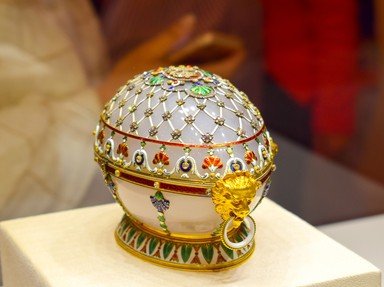Quiz Answer Key and Fun Facts
1. According to ancient legend, the pelican feeds her young on her own blood, drawn with her beak from her breast. This is known as a pelican vulning herself. On the top of the "Imperial Pelican Egg" is a model in gold and diamonds of this, a traditional image of motherly love and self-sacrifice. All the Faberge Easter eggs contain a "surprise". The surprise in the "Pelican Egg" is a series of miniature paintings on ivory, what are their subjects?
2. Another exquisite Imperial egg is known as the "Lilies-of-the-Valley Egg". It contains three delicately painted miniatures which spring from the egg when a hidden button is pressed. Who are the subjects of these?
3. In 1899, Czar Nicholas presented his wife with the "Madonna Lily Egg". It is topped with the flowers for which it is named realistically carved of white quartzite and set with rose diamond stamens. Unlike most of the Imperial egg, this has a practical purpose, even if it is still primarily a showcase for the incomparable artistry of the House of Faberge. What does this egg do?
4. The elegantly simple "Pansy Egg" is another graceful creation. The egg itself is plain and carved from nephrite jade. It sits in a mount of naturalistic leaves of silver-gilt from which rise five stems each topped with a pansy in lavender enamel, slightly paved with rose diamonds. What fact describes both this egg and the "Lily-of-the -Valley Egg"?
5. Since I'm doing these questions in chronological order, the next egg might be my favorite of the lot. It is in the "Old Russian Style". The top and bottom of the egg are enameled in rich translucent green with decorations in red and blue. It is surmounted by an Imperial Russian eagle, and stands on three griffins, supporters of the Russian arms, who hold shields and swords. Around the center is a silver band representing the occasion that the egg commemorates. What was this achievement?
6. The "Cuckoo Egg" is in an unusual Baroque/Moorish style. It contains a key-wound clock with its white enamel face on the side. Despite the name, the singing bird automaton on the top of the egg does not announce the hours, but rather works independently of the clock. Neither is it a cuckoo. What sort of bird is it?
7. Many times in these quizzes I've mentioned rose diamonds. They are Faberge's favorite form in which to use diamonds. What does rose diamond mean in the context which I've used it here?
8. The "Imperial Clover Egg" is completely covered in a tangle of clover leaves and stalks, all interwoven with a gold ribbon set with faceted rubies. Which of the following is not true of this egg?
9. In 1902 the Czar Nicholas gave his mother the "Gatchina Palace Egg". Its surprise is a tiny model of that palace. Faithfully represented in four color gold, the miniature is precise down to railings, lampposts, trees and statuary. From the topmost tower flies a standard showing the family is in residence. What was the significance of this building?
10. The "Peter the Great Egg" was presented to the dowager empress in 1903. This magnificent egg in four color gold in an elaborate rococo style celebrates the 200th anniversary of the founding of St. Petersburg. The surprise is a golden copy of the famous statue of the city's founder, Peter II "the Great", by Falconet standing on a large irregular sapphire mount. It was erected to Peter's memory by what subsequent Russian ruler?
Source: Author
griffinj
This quiz was reviewed by FunTrivia editor
thejazzkickazz before going online.
Any errors found in FunTrivia content are routinely corrected through our feedback system.
